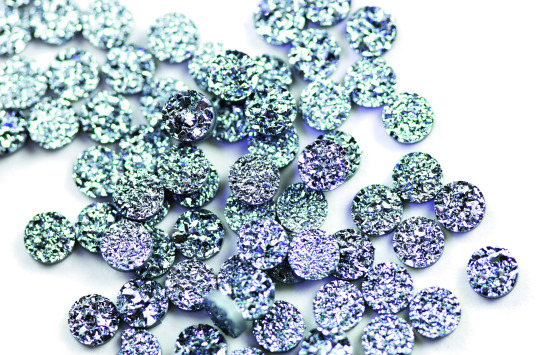#precious metal
As 2019 is drawing to a close, the Materials World team wanted to highlight a couple of stories to end the year on a high note. Today we will share the news story that got the most clicks on our website in 2019 and on Friday we will share the top feature. We hope you enjoy and Merry Christmas from the editorial team.
RARE PRECIOUS METAL OSMIUM CHALLENGES THE DIAMOND INDUSTRY
By: Shardell Joseph
Osmium in crystal form has attracted attention from jewellers and is set to rival the global diamond industry. Shardell Joseph reports.

Image credit: Osmium Institute
At least a thousand times rarer than diamonds, the aesthetic of osmium has attracted attention among jewellers and watchmakers, and experts have predicted it will challenge the global diamond industry.
Co-mined with platinum, there are 2m of osmium minable on Earth, making the metal incredibly rare. The crystallisation imparts a unique lustre, resulting in a distinct blue-silver tint, which has been nicknamed ‘the sparkle’.
Due to its high level of toxicity as a raw material, the element was previously difficult to work with, so unpopular. It has only been available for a few years after a discovery in 2013 found that crystallising the metal rendered it harmless. Now, osmium is providing opportunities for investors and possibilities for premium jewellery designs.
The Osmium Institute in Germany is globally marketing the metal in anticipation of it rivalling the diamond industry. Osmium Institute Director, Ingo Wolf, said it had been almost unavailable for three years. There were efforts in the Osmium Institute globally to negotiate individual customs agreements with individual states. He said that deals with the USA required two years, while the Australia agreements were reached quite quickly.
‘At the same time, new shapes were prepared for the jewellery market, which can serve as semi-finished products,’ Wolf said. ‘The current growth is about 100% per month. However, after a hot phase, this curve will also drop back to a more normal level if growth continues. Nonetheless, 100% per year is absolutely probable for a few years from next year.’
Osmium as a jewellery commodity is still a long way away from the value of diamond. According to Wolf, for every 0.2g, diamonds are currently valued at approximately €8,000 per carat, whereas osmium is valued at €210. However, it is highly likely the value will spike along with the demand due to the expected exponential growth of the metal.
‘Competition of cheap diamonds with Swarovski and other fiscal developments will pave the way for metals with surfaces that exceed the diamond’s radiant power,’ Wolf said.
‘The sparkle’ metal
Most commonly produced in South Africa, Canada and Russia, osmium is one of seven metals considered precious – platinum, gold, silver, palladium, iridium, rhodium and ruthenium. Among these precious metals, osmium is the rarest with the highest density. It exceeds the compression and abrasion resistance of a diamond. When osmium is cooled, it becomes a superconductor, with the capacity to transport electricity without loss.
Usually used as an alloying agent with uridium platinum and other platinum group metals, the material can be found in fountain pens and medical devices. Some compounds are used for fingerprint detection. Osmium has been used in research development as a catalyst in the process for making ammonia from combined hydrogen and nitrogen.
But handling and storing the metal is critical as its raw powdered form, called osmium sponge, is considered extremely toxic.
The powder tends to form osmium tetroxide, which is a health hazard, restricting trade of the metal between private parties.
This situation changed when it was discovered in 2013 that osmium could be crystallised and therefore detoxified. This process changes the crystal structure of osmium and hugely limits its chemical reactivity. In its unreactive crystalline form, osmium behaves even more nobly than other precious metals.
Because osmium can be crystallised in two or three-dimensional forms, osmium interests jewellers. Because of its rarity - only 30g of osmium found in 10,000t of platinum ore - its popularity among investors is expected to spike.
Among the reasons for investors to be interested in the crystallisation of osmium over diamonds are the ethical considerations.
Osmium demands very high ethical standards for sourcing the raw material. This is because the ore housing it comes from mines that supply platinum for automotive catalysts. These companies would have aready undergone a comprehensive programme to ensure compliance with strict ethical and sustainability standards. Thus investors are likely to be attracted by the guilt-free component of osmium.
